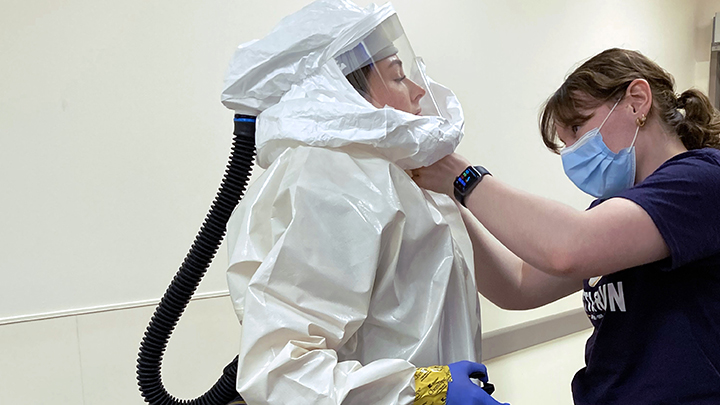
October 24, 2024

A registered nurse dons her protective gear as she prepares to assist a patient actor in a simulated emergency exercise at Medicine Hat Regional Hospital designed to boost team readiness to treat patients exposed to dangerous chemical agents. Photo supplied.
Story by Jennifer Vanderlaan
MEDICINE HAT — In the hustle and bustle of the emergency department (ED) at Medicine Hat Regional Hospital (MHRH), staff are no strangers to seeing all sorts of injuries and ailments. Rare injuries can happen at any time, however, and preparing for the unexpected is also part of the job.
Recently, the ‘unexpected’ happened in the form of a simulation that brought a ‘patient actor’ to the hospital ‘suffering’ from an accidental chemical-agent exposure. This scenario, created to promote emergency-response teamwork, saw Alberta Health Services (AHS) partner with Defence Research and Development Canada (DRDC) and Canadian Forces Base (CFB) – Suffield.
This simulation began when a DRDC ‘employee’ was exposed to a chemical substance during a training exercise. After an initial examination, base physician Dr. Kevin Warwick decided that the patient needed to be transported to MHRH for further treatment. An AHS Emergency Medical Services ambulance was dispatched to the base for the transfer to Medicine Hat.
“A key part of being prepared is to develop relationships ahead of time,” says Jeff Dutton, director, Emergency Disaster Management (ED/M) for South Zone. “Training and exercising together increases inter-agency coordination and knowledge, while enabling us to be more effective together during a real emergency."
Located 50 km north of Medicine Hat, CFB – Suffield is home to the DRDC — along with Canadian and British military forces — and provides expertise in military engineering, autonomous intelligent systems, and defence against chemical and biological agents. The base is a world-class training facility — specializing in chemical, biological, radiological and nuclear (CBRN) and other hazardous materials — and has been operating in the area since 1971.
En route to the hospital, paramedics alerted ED staff of the patient’s condition. Staff readied to receive them by donning protective suits and prepping the decontamination room — a dedicated space in the hospital which allows staff to safely clean and decontaminate patients who may have been exposed to hazardous substances, infectious agents, and other contaminants.
Prior to their admission, ED staff also secured the area to protect patients, staff and other care areas from potential exposure.
Protective suits, often referred to as hazmat suits, are impermeable and fully enclose the individual to protect them from gases and vapors. Rarely used in a healthcare setting, donning them requires training, practice and assistance.
Once clad in their protective gear, registered nurses (RNs) Ciara Bonogofski and Jayci Howe transferred the patient from the paramedics — and quickly began the process of decontamination — taking care to clean every inch of her skin, while remaining vigilant to avoid cross-contamination.
As the RN’s tended to their patient, the base physician briefed additional AHS staff on the incident, sharing what treatment had already been provided, along with recommendations for further care. This collaborative approach helped both the DRDC and ED physicians quickly come up with a comprehensive treatment plan to ensure a positive outcome.
At the end of the exercise, all the participants gathered for one of the most crucial components of any exercise — the debrief. It’s designed to foster learning and collaboration as well as to evaluate the effectiveness of the response. All are encouraged to openly share what went well, and what challenges arose. The debrief concluded with a list of recommendations and actions to bolster readiness for future real-life emergencies.
This emergency exercise, meticulously planned by both AHS and DRDC, exposed staff to a unique health situation to help them build upon their confidence, resilience and responsiveness — and to foster better communication between their organizations.
“Managing a patient with exposure to chemical warfare agents is thankfully not something that we experience regularly,” says SaraLyn Duque, emergency management officer, ED/M, South Zone.
“It’s a unique opportunity to collaborate with DRDC in their area of expertise and build our skills clinically and relationally in a no-fault environment.”
Emergency exercises play a critical role in ensuring that healthcare organizations can respond effectively to any crisis, safeguarding both patients and staff. Planning for these rare and often-unexpected events strengthens existing processes and relationships.
“The opportunity for AHS staff to practise and train with global leaders in CBRN and hazardous materials proved invaluable,” says Dutton.
“This exercise reminded staff that preparing for the unexpected ensures that our organization can face any challenge, no matter how rare, that may come our way.”